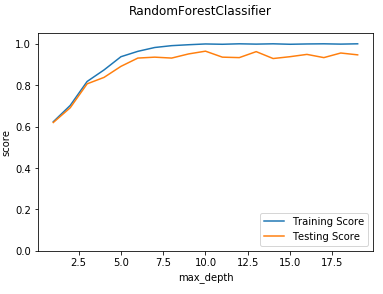吴裕雄 python 机器学习——集成学习随机森林RandomForestClassifier分类模型
import numpy as np
import matplotlib.pyplot as plt from sklearn import datasets,ensemble
from sklearn.model_selection import train_test_split def load_data_classification():
'''
加载用于分类问题的数据集
'''
# 使用 scikit-learn 自带的 digits 数据集
digits=datasets.load_digits()
# 分层采样拆分成训练集和测试集,测试集大小为原始数据集大小的 1/4
return train_test_split(digits.data,digits.target,test_size=0.25,random_state=0,stratify=digits.target) #集成学习随机森林RandomForestClassifier分类模型
def test_RandomForestClassifier(*data):
X_train,X_test,y_train,y_test=data
clf=ensemble.RandomForestClassifier()
clf.fit(X_train,y_train)
print("Traing Score:%f"%clf.score(X_train,y_train))
print("Testing Score:%f"%clf.score(X_test,y_test)) # 获取分类数据
X_train,X_test,y_train,y_test=load_data_classification()
# 调用 test_RandomForestClassifier
test_RandomForestClassifier(X_train,X_test,y_train,y_test)

def test_RandomForestClassifier_num(*data):
'''
测试 RandomForestClassifier 的预测性能随 n_estimators 参数的影响
'''
X_train,X_test,y_train,y_test=data
nums=np.arange(1,100,step=2)
fig=plt.figure()
ax=fig.add_subplot(1,1,1)
testing_scores=[]
training_scores=[]
for num in nums:
clf=ensemble.RandomForestClassifier(n_estimators=num)
clf.fit(X_train,y_train)
training_scores.append(clf.score(X_train,y_train))
testing_scores.append(clf.score(X_test,y_test))
ax.plot(nums,training_scores,label="Training Score")
ax.plot(nums,testing_scores,label="Testing Score")
ax.set_xlabel("estimator num")
ax.set_ylabel("score")
ax.legend(loc="lower right")
ax.set_ylim(0,1.05)
plt.suptitle("RandomForestClassifier")
plt.show() # 调用 test_RandomForestClassifier_num
test_RandomForestClassifier_num(X_train,X_test,y_train,y_test)

def test_RandomForestClassifier_max_depth(*data):
'''
测试 RandomForestClassifier 的预测性能随 max_depth 参数的影响
'''
X_train,X_test,y_train,y_test=data
maxdepths=range(1,20)
fig=plt.figure()
ax=fig.add_subplot(1,1,1)
testing_scores=[]
training_scores=[]
for max_depth in maxdepths:
clf=ensemble.RandomForestClassifier(max_depth=max_depth)
clf.fit(X_train,y_train)
training_scores.append(clf.score(X_train,y_train))
testing_scores.append(clf.score(X_test,y_test))
ax.plot(maxdepths,training_scores,label="Training Score")
ax.plot(maxdepths,testing_scores,label="Testing Score")
ax.set_xlabel("max_depth")
ax.set_ylabel("score")
ax.legend(loc="lower right")
ax.set_ylim(0,1.05)
plt.suptitle("RandomForestClassifier")
plt.show() # 调用 test_RandomForestClassifier_max_depth
test_RandomForestClassifier_max_depth(X_train,X_test,y_train,y_test)

def test_RandomForestClassifier_max_features(*data):
'''
测试 RandomForestClassifier 的预测性能随 max_features 参数的影响
'''
X_train,X_test,y_train,y_test=data
max_features=np.linspace(0.01,1.0)
fig=plt.figure()
ax=fig.add_subplot(1,1,1)
testing_scores=[]
training_scores=[]
for max_feature in max_features:
clf=ensemble.RandomForestClassifier(max_features=max_feature)
clf.fit(X_train,y_train)
training_scores.append(clf.score(X_train,y_train))
testing_scores.append(clf.score(X_test,y_test))
ax.plot(max_features,training_scores,label="Training Score")
ax.plot(max_features,testing_scores,label="Testing Score")
ax.set_xlabel("max_feature")
ax.set_ylabel("score")
ax.legend(loc="lower right")
ax.set_ylim(0,1.05)
plt.suptitle("RandomForestClassifier")
plt.show() # 调用 test_RandomForestClassifier_max_features
test_RandomForestClassifier_max_features(X_train,X_test,y_train,y_test)

吴裕雄 python 机器学习——集成学习随机森林RandomForestClassifier分类模型的更多相关文章
- 吴裕雄 python 机器学习——集成学习随机森林RandomForestRegressor回归模型
import numpy as np import matplotlib.pyplot as plt from sklearn import datasets,ensemble from sklear ...
- 吴裕雄 python 机器学习——集成学习梯度提升决策树GradientBoostingRegressor回归模型
import numpy as np import matplotlib.pyplot as plt from sklearn import datasets,ensemble from sklear ...
- 吴裕雄 python 机器学习——集成学习AdaBoost算法回归模型
import numpy as np import matplotlib.pyplot as plt from sklearn import datasets,ensemble from sklear ...
- 吴裕雄 python 机器学习——集成学习AdaBoost算法分类模型
import numpy as np import matplotlib.pyplot as plt from sklearn import datasets,ensemble from sklear ...
- 机器学习:集成学习:随机森林.GBDT
集成学习(Ensemble Learning) 集成学习的思想是将若干个学习器(分类器&回归器)组合之后产生一个新学习器.弱分类器(weak learner)指那些分类准确率只稍微好于随机猜测 ...
- 吴裕雄 python 机器学习——伯努利贝叶斯BernoulliNB模型
import numpy as np import matplotlib.pyplot as plt from sklearn import datasets,naive_bayes from skl ...
- 吴裕雄 python 机器学习——数据预处理过滤式特征选取SelectPercentile模型
from sklearn.feature_selection import SelectPercentile,f_classif #数据预处理过滤式特征选取SelectPercentile模型 def ...
- 吴裕雄 python 机器学习——数据预处理过滤式特征选取VarianceThreshold模型
from sklearn.feature_selection import VarianceThreshold #数据预处理过滤式特征选取VarianceThreshold模型 def test_Va ...
- 吴裕雄 python 机器学习——数据预处理字典学习模型
from sklearn.decomposition import DictionaryLearning #数据预处理字典学习DictionaryLearning模型 def test_Diction ...
随机推荐
- LaTeX技巧009:中国象棋的LaTeX排版
Latex可以排版容易排版中国象棋, 围棋, 国际象棋棋谱和乐谱, 详情请见. http://bbs.chinatex.org/forum.php?mod=viewthread&tid=498 ...
- 数据升级包 - bin文件
运行完升级包后,正常的现象 开头: 结尾:
- Spring5源码阅读环境搭建-gradle构建编译
前沿:Spring系列生态十分丰富,涉及到各个方面.但是作为Spring生态的核心基础Spring,是最重要的环节,需要理解Spring的设计原理,我们需要解读源码. 在构建Spring源码阅 ...
- lnmp1.5一键安装包安装lnmpa后,添加站点
lnmp1.5一键安装包安装lnmpa后,添加站点 (1)添加站点 (2)配置apache配置文件 在/usr/local/apache/conf/vhost文件夹下,修改webApp站点配置文件ap ...
- 意外发现--http-server使用
http-server 在很多情况下,需要在本地开启http服务器来测试.所以就需要一个简单的省事好用的http服务器.以前的时候,都是使用php的本地环境,但是,自从学了nodejs,发现了http ...
- poj-2253(最小瓶颈路问题)
题目链接 Description Freddy Frog is sitting on a stone in the middle of a lake. Suddenly he notices Fion ...
- git回退版本: 回退本地代码版本 + 回退服务器代码版本
1.回退本地代码版本 借助IDEA开发工具回退版本,点击Version Control ,查看历史版本号: 右击想要回退的版本号,选择Reset Current Branch hear... 选择 H ...
- gets(), getline(), cin.getline()
gets(str), getline(cin, s), cin.getline(str, len),这三个函数都是读入一行字符串的函数,下面是这三个函数的区别 1. gets() 函数是 C 语言的函 ...
- Tomcat/conf/server.xml文件中docBase和path的说明
Tomcat的项目部署方式有以下三种: 1.直接把项目复制到Tomcat安装目录的webapps目录中,这是最简单的一种Tomcat项目部署的方法.2.在tomcat安装目录中有一个conf文件夹,打 ...
- Linux 配置mysql 远程连接
1.首先用root用户登录mysql mysql -u root -p 2.新建用户 use mysql; select host,user from user;(查看现有用户) CREATE USE ...
